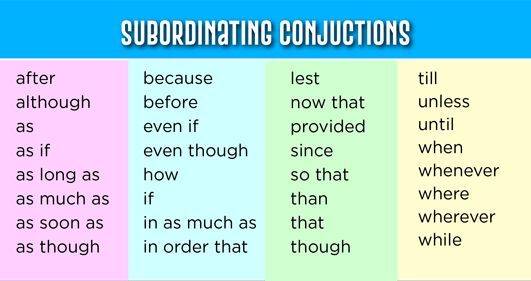오늘은 부사절을 이끄는 종속접속사 중에서 "때, 시간"의 부사절과 "원인, 이유"의 부사절에 대해서 알아보겠습니다. 부사절은 부사처럼 쓰이므로 문장에서 없어져도 주절에 전혀 영향이 가지 않습니다.

"때, 시간"의 부사절
: when, as, after, since, till, as long as, the moment, as soon as 등
1. 「while 주어 + 동사 : ~하는 동안」, 「, while 주어 + 동사 : 반면에 ~」
● While you were away, there was a fire in the neighborhood.
(당신이 멀리 나가있을 동안에, 이웃에서 불이 났었습니다.)
● I have read fifty pages, while he has read only thirty.
(나는 50장을 읽었다, 반면에 그는 단지 30장 만을 읽었다.)
2. till (= until : 드디어) = , and at least
● He drove wildly, till he ran into a truck.
(그는 난폭하게 운전했다, 드디어 그는 트럭을 받았다.)
3. not (no) A until (till) B : B 한 뒤에야 비로소 A 하다
= It is not until B that A = Not until B + A
● We do not know the value of health until we lose it.
(우리는 건강을 잃고 난 뒤에야 비로소 건강의 소중함을 안다.)
= No one knows the value of health until we lose it.
= It is not until we lose it that we know the value of health. <강조 구문>
= Not until we lose it do we know the value of health.
4. It will not be belong before ~ (= before long, soon)
: 얼마 안 가서 ~하다, 오래지 않아(곧) ~ 하다.
● It will not be long before the new model is on sale.
(머지않아 새로운 모델이 시판될 것이다.)
<비교>
It will be a long time before ~ : 얼마 지나서야 ~
It will be some time before ~ : 얼마가 지나서야 ~
● It will be a long time before we meet again.
(얼마 지나서야 우리는 다시 만났다.)
● It will be some time before he notices it.
(얼마가 지나서야 그는 그것을 알아차렸다.)
5. No sooner ~ than = hardly (or scarecely) ~ before (or when)
= as soon as = on ~ing = the moment (or the instant, or the mimute)
= directly (or instantly, or immediately ) : ~하자마자
● As soon as she saw him, she turned pale.
(그녀가 그를 보자마자 그녀는 창백해졌다.)
= No sooner had she seenhim than she turned pale.
= Hardly (Scarecely) had she seen him when (before) she turned pale.
= On seeing him, she turned pale.
= The moment (The instant, The minute) she saw him, she turned pale.
= Immediately (Directly, Instantly) she saw him, she turned pale.
<주의> no sooner, hardly, scarcely가 문장의 앞으로 나올 때는 「had + 주어 + 과거분사」의 어순이 됨에 유의해야 함.
6. as long as (= while) : ~하는 동안, ~하기만 하면, ~하는 한.
so long as (= if only) : ~하는 한
● I shall never forget your kindness as long as I live.
(나는 살아있는 한 너의 친절함을 잊지 않을 것이다.)
● I waited for him as long as three hours.
(나는 그를 3시간 동안 기다렸다.)
● I will study hard as long as I am a student.
(학생인 동안은 나는 열심히 공부하겠다.)
● I will read the book so long as it is interesting.
(그 책이 재미가 있는 한 나는 그 책을 읽겠다.)
7. 주어 + had not + p.p ~ when ··· : ~하지 못해 ··· 하다.
주어 + had not + p.p ~ before ··· : ~하지 않아 ··· 하다.
● I had not gone very far when I was caught in a shower.
(나는 그다지 멀리 가지 못해서 소나기를 만났다.)
● I had not walked a mile before I got tired.
(나는 일 마일도 가지 못해서 지쳐버렸다.)
8. every time (= each time, = whenever) 주어 + 동사 : ~할 때마다
next time + 주어 + 동사 : 다음에 ~ 할 때
● Every time she comes to see me, she comes with her son.
(그녀가 나에게 올 때마다 그녀의 아들과 함께 온다.)
● Next time you're about to speak, stop and say these words to yourself.
(다음에 네가 막 말하려 할 때에 멈춰서 너 자신에게 이 말을 해라.)
"원인, 이유"의 부사절
: because, since, as, now that 등
1. not A because B : B라고 해서 A는 아니다.
● Do not despise a man because he is poor.
(가난하다고 해서 사람을 멸시하지 말아라.)
2. not because A but because B : A 때문이 아니라 B 때문이다.
= not that A but that B
● He passed the examination not because he was lucky, but because he worked hard.
(그는 운이 좋았기 때문이 아니라 열심히 공부했기 때문에 시험에 통과했다.)
3. now that = since = becaust : ~이니까, ~이므로
● Now that she is no more, I have no one to love.
(그 여자가 없으므로, 나는 사랑할 사람이 아무도 없다.)
4. seeing that : ~을 생각하면, ~이기 때문에
● Seeing that he is not preparing at all, he seems to have no mind to take the examintion.
(그가 전혀 준비되지 않는 것을 생각한다면 그는 시험을 치를 마음이 없는 것 같다.)
이렇게 해서 오늘은 '때, 시간'과 '원인, 이유'의 부사절에 대해 공부해 봤습니다. 다음 시간에는 '목적, 결과'의 부사절에 대해 알아보겠습니다.
★함께 읽으면 도움 되는 글★
접속사: 접속사의 종류, 등위(상관)접속사 and, but
접속사는 단어와 단어, 문장과 문장을 연결해 주는 말입니다. 접속사의 종류는 크게 등위접속사와 종속접속사가 있습니다. 등위접속사는 대등한 관계로 이어주는 접속사이고 종속접속사는 의
pure.bhs0130.com
접속사: 등위접속사 or, 명사절을 이끄는 종속접속사
오늘은 지난 시간에 이어 등위접속사 or와 명사절을 이끄는 종속접속사 that, if, whether에 대해 알아보겠습니다. 명사절을 이끄는 종속접속사는 명사처럼 주어, 목적어, 보어 자리에 옵니다. 등위
pure.bhs0130.com
'영어 문법 공부해 보자' 카테고리의 다른 글
| '명령형 양보' 부사절, '양태'의 부사절, '조건'의 부사절 (1) | 2023.07.24 |
|---|---|
| '목적, 결과'의 부사절, '양보'의 부사절을 이끄는 접속사 (0) | 2023.07.23 |
| 접속사: 등위접속사 or, 명사절을 이끄는 종속접속사 (0) | 2023.07.21 |
| 접속사: 접속사의 종류, 등위(상관)접속사 and, but (1) | 2023.07.20 |
| 화법 전환: 중문, 복문, 문장의 종류가 다른 경우, 묘출화법 (0) | 2023.07.19 |




